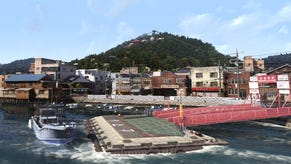Yakuza: Dead Souls Review
Don't scream it's over.
By contrast, it feels like Sega is starting back at square one in Dead Souls. There's a bit of Dead Rising here, a little Resi there; you can strafe and shoot, but you can't move while aiming. Pressing the square button to fire is an odd way of doing things, but you do get accustomed to it. For the most part, however, you won't bother aiming; with zombies liable to overwhelm you within seconds, you rarely have time to tug that camera over your shoulder. Instead, you're better off just rolling out of trouble and letting off a few rounds in the rough direction of your assailants.

Periodically, you'll get the opportunity to pull off environmental kills, pressing a button when within range of an explosive barrel or similarly combustible object to trigger an event as your bullet speeds towards its target. Elsewhere, there are a few area-specific hazards like water outlets or electricity boxes or - on one memorable occasion - a container of liquid nitrogen, the aftermath allowing you to pick up the zombies you've frozen to use as melee weapons.
It isn't enough to prevent the gunplay from getting repetitive, with the vast majority of context-sensitive specials playing out in the same way, lacking the invention or the range of the Heat moves in earlier games. With such plentiful ammunition and an easy default difficulty, it's unlikely many will get frustrated, but the action sequences can't help but feel like a step backwards for Yakuza.
Similarly, the story struggles to leave a mark. Again, we start with Akiyama, who manages to sleep through the opening hours of the apocalypse before venturing outside to rescue chubby secretary Hana while fending off the zombie onslaught. Akiyama's easygoing charm carries this opening chapter, but his story functions as little more than a tutorial.
Yakuza 2's antagonist, Ryuji Goda, gets a little more to do, returning to Kamurocho with a minigun for a right arm and a neat line in growly threats. His backstory is fleshed out with interludes that show him running a takoyaki stand, a past you know will end up being significant, and so it proves. It's one of those occasions where Yakuza treats something ridiculous in such an earnest manner that it's impossible not to warm to it.

Meanwhile, Kazuma is dragged back to his old stomping ground once more to rescue kidnapped Haruka yet again. He gets a nice character beat with a recently-turned zombie, fighting alongside a gutsy female soldier who is one of the few new characters to make any kind of impact. But replace zombies with suited gangsters and we've made this journey before. And as essential as his stoicism was for making the emotional wringer of Yakuza 3's Chapter 11 that much more affecting, he's not the charismatic force he once was.
Thank heavens, then, for Goro Majima, who, in one chapter and a couple of all-too-brief further appearances, manages to walk off with the entire game. Introduced watching zombie films in his penthouse suite (there's a gorgeous panoramic view of Tokyo through a window as he makes his escape) he seems more amused than upset by this turn of events, refusing to let this inconvenience him in any way.
He also gets the best side-mission in the game: a sequence where he convinces Tojo Clan leader Daigo Dojima to dress as a girl to lure out zombies after hearing they target couples. Throw in a hysterical karaoke sequence and a heroically daft moment at the death and it's clear that Dead Souls was worth making, if only to give Majima a turn in the spotlight.
Otherwise, it's a clutch of memorable moments that don't quite gel into a wholly satisfying climax. Still, it's unlikely that fans will be left with anything other than warm feelings for a series that has never quite got the praise it deserved.


